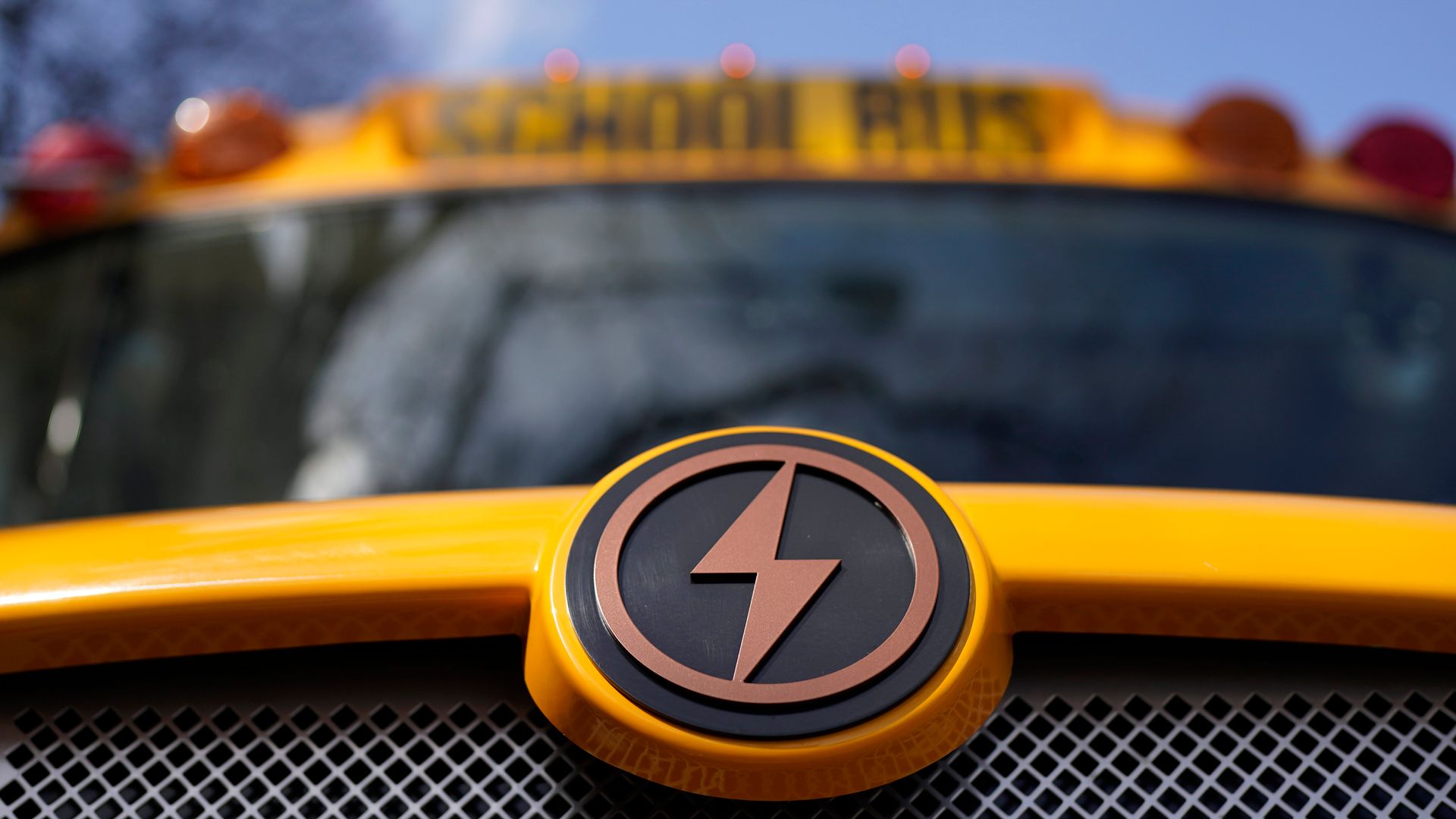
[JACK ALYMER]
SCHOOL BUSES HAVEN’T CHANGED MUCH IN DECADES.
THE ICONIC BIG YELLOW VEHICLE HAS BEEN AN AMERICAN STAPLE.
BUT THE WAY KIDS ACROSS THE COUNTRY GET TO SCHOOL IS NOW CHANGING.
MORE ELECTRIC SCHOOL BUSES ARE HITTING U.S. ROADWAYS THAN EVER BEFORE.
JUMPING BY MORE THAN TWO HUNDRED PERCENT SINCE THE START OF 20-22.
THERE ARE NOW ELECTRIC BUS COMMITMENTS IN FORTY NINE STATES AND THE E.P.A. PROJECTS THAT BY 20-27 NEARLY A THIRD OF ALL SCHOOL BUSES MADE WILL BE EVS.
THE PUSH TO ELECTRIFY IS BEING FUELED PARTLY BY A FEDERAL REBATE PROGRAM, PUMPING BILLIONS OF DOLLARS FROM THE BIPARTISAN INFRASTRUCTURE LAW INTO SCHOOL SYSTEMS ACROSS THE COUNTRY.
THE GOAL – TO REPLACE EXISTING FLEETS WITH ZERO-EMISSION MODELS.
[KAMALA HARRIS]
“I’m so excited about these electric school buses. And when I think about what we have been able to do through the infrastructure law, what it means is that we have now invested and that’s the announcement today $5 billion over the next five years.”
[JACK ALYMER]
TO KEEP UP WITH GROWING DEMAND, ONE OF AMERICA’S OLDEST SCHOOL BUS MANUFACTURERS, BLUE BIRD, IS EVOLVING.
THE COMPANY IS CONSTRUCTING A NEW EV BUILD-UP CENTER WHICH THEY SAY, WILL INCREASE PRODUCTION CAPACITY FIVE-FOLD.
THIS WOULD ULTIMATELY ALLOW BLUE BIRD TO OUTPUT AROUND FIVE THOUSAND ELECTRIC BUSES A YEAR.
[PHIL HORLOCK]
“This is our new zero emission electric school bus. It is extremely quiet. It has plenty of power. We even had to install a noise generator to emit some type of noise because it is super quiet. Phantom power and you’ll be amazed.”
[JACK ALYMER]
THE COMPANY’S CEO SAYS THEY ARE ANTICIPATING THOUSANDS OF ORDERS FOR THESE VEHICLES – WITH AN ESTIMATED VALUE OF ONE BILLION DOLLARS OVER THE NEXT FIVE YEARS.
EXPERTS ARE ON BOARD WITH THE PLAN. CITING A NUMBER OF POTENTIAL BENEFITS COMING FROM THE TRANSITION.
A STUDY BY THE WORLD RESOURCES INSTITUTE FOUND THAT ELECTRIFYING THE FULL U.S. SCHOOL BUS FLEET BY 20-30 WOULD SIGNIFICANTLY REDUCE GREENHOUSE GAS EMISSIONS.
THE AMOUNT WOULD BE EQUIVALENT TO TAKING TWO MILLION CARS OFF THE ROAD.
EACH ELECTRIC SCHOOL BUS PRODUCES LESS THAN HALF THE EMISSIONS OF THEIR DIESEL OR PROPANE-POWERED COUNTERPART.
[KEVIN MATTHEWS]
“When you convert that to zero emissions, the air quality improvement is even significantly higher. So the overall benefits are quite high for the environment for the children and for the communities where the school buses operate.”
[JACK ALYMER]
THERE ARE ALSO FEWER HEALTH RISKS WHEN COMPARED TO THE MORE THAN FORTY TOXIC AIR CONTAMINANTS COMING FROM THE EXHAUST FUMES OF DIESEL BUSES.
[MICAEL REGAN]
“It’s good for the children because they’re breathing cleaner air. And it’s good for the parents because they can feel good sending their kids to school, knowing that one child or their children might have one less asthma attack because they’re not exposed to diesel pollution. So this is a win win win.”-EPA Administrator Michael Regan
[SCOTT BUXBAUM]
“Our students riding on the buses, our staff driving the buses, you know, right now, there’s pollution everyday coming in on our diesel fleet … Electrification is where it’s going.”
[JACK ALYMER]
ACCORDING TO THE ELECTRIC SCHOOL BUS INITIATIVE, THEY SAVE SCHOOL DISTRICTS MONEY TOO.
A REDUCTION OF SIX-THOUSAND DOLLARS A YEAR ON AVERAGE OPERATIONAL COSTS.
[TIMOTHY SHANNON]
“Clean air, zero emission electric school buses after running them for over two years, we have found significant reduction in cost of operation, about 80% reduction in maintenance costs. Overall, the running of electric vehicles is much less expensive than running a diesel vehicle.”
[JACK ALYMER]
BUT THE PLAN IS NOT WITHOUT ITS CRITICS.
OPPONENTS SAY A MASS ADOPTION OF ELECTRIC SCHOOL BUSES JUST ISN’T PRACTICAL.
WHILE MAINTENANCE COSTS FOR E-VS ARE LOWER THAN THOSE OF COMBUSTION ENGINE BUSES – THE UPFRONT EXPENSE IS 3-TO-4 TIMES HIGHER.
THAT PUTS THE PRICE TAG OF A NEW BIG YELLOW BUS AT AROUND THREE-HUNDRED-AND-FIFTY-THOUSAND TO FOUR-HUNDRED-FIFTY-THOUSAND-DOLLARS.
THE RANGE OF THESE E-V BATTERIES IS ANOTHER FACTOR.
THEIR AVERAGE RANGE – CAPPED AT AROUND ONE-HUNDRED-MILES.
AS IF FIELD TRIPS WEREN’T HARD ENOUGH FOR BUS DRIVERS.
RURAL COMMUNITIES ARE ALSO VOICING CONCERNS.
THE SCARCITY OF EV CHARGERS AND THE TOLL ELECTRIC SCHOOL BUSES WOULD TAKE ON THEIR LOCAL POWER GRID – ARE TOP OF MIND FOR MANY.
[ROBERT AUTH]
“I’d be all for this if the technology was ready to roll, and to transport our children safely in the cabins, back and forth to school …It’s not working properly at this time, the technology is not there yet to be implemented.”
[JACK ALYMER]
OFFICIALS ARE HOPING GOVERNMENT FUNDING WILL HELP CLEAR THESE HURDLES, BY MAKING CHARGING TECHNOLOGY MORE WIDELY AVAILABLE AND BY REDUCING THE COSTS FACED BY SCHOOL DISTRICTS.
[SUE GANDER]
“What … the bipartisan infrastructure act … did was create a new $5 billion Clean School Bus program. One half of that funding 2.5 billion is dedicated solely to funding electric school buses infrastructure.”
[JACK ALYMER]
AND THE CLOCK IS TICKING TO FACE THESE CHALLENGES.
THERE ARE DEADLINES ACROSS THE COUNTRY, WITH MANY MANDATING A PUSH TO PURCHASE ONLY ELECTRIC SCHOOL BUSES GOING FORWARD.
SO WHILE WHAT’S UNDER THE HOOD COULD BE CHANGING QUICKLY, AT LEAST THE ICONIC YELLOW PAINT JOB SEEMS TO BE HERE TO STAY.








